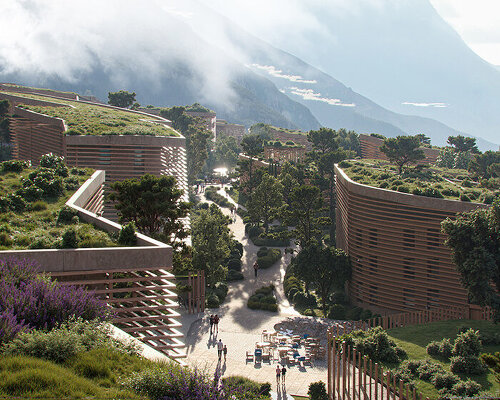renneria: a new neighborhood for the italian dolomites
On the edge of Bolzano, Italy a new neighborhood designed by NOA is set to take shape. Located within the South Tyrolean landscape, Renneria explores a model of development based on agricultural continuity and everyday livability. The 13-hectare site in Pineta di Laives — named after 14th-century farmstead Maso Renner — embodies respect for history and contemporary ambition.
Promoted by the Gazzini real estate group, the project transforms a formerly agricultural area bordered by existing settlements and infrastructure. It offers a considered response to one of the region’s most urgent challenges: the need for sustainable housing growth.
‘Renneria’s location makes it naturally suited to accommodate a new district,’ explain Luca and Matteo Gazzini. ‘Bordering a settlement, an artisan district, and an arterial road, it already belongs to an urbanized fabric. Renneria harmoniously completes this development.’
visualizations © Cosmoscube (unless otherwise stated)
noa plans a compact village in the mountains
NOA’s Renneria masterplan introduces around 800 residential units within a system that integrates housing, workspaces, education, and leisure. The architects‘ masterplan reflects the studio’s belief in functional proximity — a model where services are within reach, and movement occurs on foot, by bicycle, or public transport. Streets become linear gardens, courtyards encourage interaction, and the organization mimics a compact village.
‘Four words guided our vision: residential, cultural, communal, and collaborative,’ says Lukas Rungger, NOA’s founder and project architect. ‘Residential, because we offer diverse and inclusive housing typologies. Cultural, because new institutions stimulate the district’s intellectual life. Communal, because Renneria retains the scale of a village. And collaborative, with urban gardens at the core of this participatory dimension.’
NOA introduces Renneria, a new neighborhood designed for the Dolomites
a masterplan shaped by agriculture
The Renneria masterplan by NOA is centered around agriculture. Productive landscapes including urban gardens, orchards, and green roofs extend the legacy of Maso Renner while shaping new forms of social life. They function as local food systems and educational spaces where people can gather.
‘Renneria will host a one-of-a-kind agricultural school, a true open-air laboratory,’ add the Gazzini brothers. ‘The 70,000 square meters of greenery, fruit trees, herbs, and biotopes will become an integral part of the educational path, transforming the neighborhood into a distributed classroom.’
This greenery unfolds through varying topographies. To the west, a linear park buffers the traffic corridor while offering a shaded pedestrian and cycling route. Green corridors radiate outward, connecting to the panoramic Seit viewpoint, where a new belvedere will frame views across the valley and the Dolomites.
the 13 hectare site in Pineta di Laives extends Bolzanos urban edge with a mixed-use community
The neighborhood’s public life is organized between on three squares. ‘They are designed for social interaction, safety, and urban vibrancy,’ explains Andrea Dal Negro, architect at NOA. ‘Through fountains, trees, and paving variations, these spaces act as outdoor living rooms, active throughout the year.‘
Each square establishes a distinct character: the southern one for markets, the central one for cafés and shops, and the northern one for education, with student housing and workshops interwoven with play and learning.
Mobility follows a clear hierarchy. A ring road borders the site, with underground parking at key points. Inside, streets prioritize greenery and slow movement. Pedestrian and cycling paths define the internal grid, reinforced by three kilometers of bike lanes. Of course, the absence of traffic enhances air quality and reduces noise pollution.
NOA’s walkable neighborhood integrates housing, workspaces, education, and leisure spaces
Architecturally, Renneria evolves from the terrain itself. NOA’s concept of ‘extruding the landscape‘ transforms contour lines into built form. Buildings rise gently with the slope, mediating between the city and the surrounding countryside.
Facades are clad in timber slats — horizontal for residential volumes, vertical for civic buildings — creating a quiet interplay of texture and rhythm beneath the Dolomite light. Green roofs extend this dialogue, functioning as communal gardens and energy buffers.
‘The buildings vary in height to preserve panoramic views and maximize natural light and ventilation,‘ says Dal Negro. ‘For public structures on sloping ground, entrances appear on multiple levels, producing layered, engaging spaces.‘
public squares, fountains, and green corridors define a pedestrian-oriented masterplan
timber facades and green roofs merge the architecture with the landscape | image © NOA
buildings follow the natural slope to create continuity between city and countryside
project info:
name: Renneria
architect: NOA | @networkofarchitecture
location: Pineta di Laives, Italy
visualizations: © NOA, © Cosmoscube | @cosmoscube
The post NOA plans lush, walkable neighborhood ‘renneria’ in italian dolomites appeared first on designboom | architecture & design magazine.

